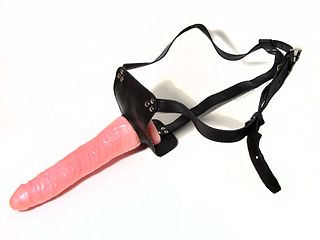Anal sex or anal intercourse is generally the insertion and thrusting of the erect penis into a person's anus, or anus and rectum, for sexual pleasure. Other forms of anal sex include anal fingering, the use of sex toys, anilingus, pegging, as well as electrostimulation and erotic torture such as figging. Although anal sex most commonly means penile–anal penetration, sources sometimes use anal intercourse to exclusively denote penile–anal penetration, and anal sex to denote any form of anal sexual activity, especially between pairings as opposed to anal masturbation.

The clitoris is a female sex organ present in mammals, ostriches, and a limited number of other animals. In humans, the visible portion – the glans – is at the front junction of the labia minora, above the opening of the urethra. Unlike the penis, the male homologue (equivalent) to the clitoris, it usually does not contain the distal portion of the urethra and is therefore not used for urination. In most species, the clitoris lacks any reproductive function. While few animals urinate through the clitoris or use it reproductively, the spotted hyena, which has an especially large clitoris, urinates, mates, and gives birth via the organ. Some other mammals, such as lemurs and spider monkeys, also have a large clitoris.

Orgasm, or sexual climax, is the sudden discharge of accumulated sexual excitement during the sexual response cycle, resulting in rhythmic, involuntary muscular contractions in the pelvic region characterized by sexual pleasure. Experienced by males and females, orgasms are controlled by the involuntary or autonomic nervous system. They are usually associated with involuntary actions, including muscular spasms in multiple areas of the body, a general euphoric sensation, and, frequently, body movements and vocalizations. The period after orgasm is typically a relaxing experience, attributed to the release of the neurohormones oxytocin and prolactin as well as endorphins.

The G-spot, also called the Gräfenberg spot, is characterized as an erogenous area of the vagina that, when stimulated, may lead to strong sexual arousal, powerful orgasms and potential female ejaculation. It is typically reported to be located 5–8 cm (2–3 in) up the front (anterior) vaginal wall between the vaginal opening and the urethra and is a sensitive area that may be part of the female prostate.

A cock ring or cockring is a ring worn around the penis, usually at the base. The primary purpose of wearing a cock ring is to restrict the flow of blood from the erect penis to produce a stronger erection or to maintain an erection for a longer period of time. Medically, they are sometimes used on their own, or in conjunction with a penis pump to assist in the management of erectile dysfunction. Genital adornment is another purpose, as is repositioning the genitals to provide an enhanced appearance.

The missionary position or man-on-top position is a sex position in which, generally, a woman lies on her back and a man lies on top of her while they face each other and engage in vaginal intercourse. The position may also be used for other sexual activity, such as anal sex. It is commonly associated with heterosexual sexual activity, but is also used by same-sex couples.

Sexual stimulation is any stimulus that leads to, enhances and maintains sexual arousal, and may lead to orgasm. Although sexual arousal may arise without physical stimulation, achieving orgasm usually requires it.

Fingering is sexual stimulation of the vulva or vagina by using the fingers. Vaginal fingering is legally and medically called digital penetration or digital penetration of the vagina. The term "digital" takes its significance from the English word 'digit,' which refers to a finger, thumb, or toe. Fingering may also include the use of fingers to stimulate the anus.

A strap-on dildo is a dildo designed to be worn, usually with a harness, during sexual activity. Harnesses and dildos are made in a wide variety of styles, with variations in how the harness fits the wearer, how the dildo attaches to the harness, as well as various features intended to facilitate stimulation of the wearer or a sexual partner. Strap-on dildos are most frequently used by lesbian women, but can be used by people of any gender or sexuality.

Mary Roach is an American author specializing in popular science and humor. She has published seven New York Times bestsellers: Stiff: The Curious Lives of Human Cadavers (2003), Spook: Science Tackles the Afterlife (2005), Bonk: The Curious Coupling of Science and Sex (2008), Packing for Mars: The Curious Science of Life in the Void (2010), Gulp: Adventures on the Alimentary Canal (2013), Grunt: The Curious Science of Humans at War (2016), and Fuzz: When Nature Breaks the Law (2021).

A G-spot vibrator is a sex toy with female and male varieties. The female version of the device is built to massage the G-spot, described as a bean-shaped area of the vagina. Some women report that it is an erogenous zone which, when stimulated, can lead to strong sexual arousal, powerful orgasms and female ejaculation. The male version of the G-spot vibrator is used for massaging the prostate for both sexual and health-related reasons.

Non-penetrative sex or outercourse is sexual activity that usually does not include sexual penetration. It generally excludes the penetrative aspects of vaginal, anal, or oral sex, but includes various forms of sexual and non-sexual activity, such as frottage, manual sex, mutual masturbation, kissing, or cuddling. Some forms of non-penetrative sex, particularly when termed outercourse, include penetrative aspects, such as penetration that may result from forms of fingering or oral sex.

Masturbation is a form of autoeroticism in which a person sexually stimulates their own genitals for sexual arousal or other sexual pleasure, usually to the point of orgasm. The stimulation may involve the use of hands, fingers, everyday objects, sex toys, or more rarely, the mouth. Manual sex may or may not be considered masturbation.
OneTaste is a business which was primarily dedicated to teaching the practices of orgasmic meditation (OM) and slow sex. Though it embraced ideas based in Eastern philosophy, the central focus was a meditation practice around the sensation of a man touching a woman's genitalia. It was founded by Nicole Daedone in San Francisco. The company started to receive more widespread attention around 2007.
The one-sex and two-sex theories are two models of human anatomy or fetal development discussed in Thomas Laqueur's book Making Sex: Body and Gender from the Greeks to Freud. Laqueur theorizes that a fundamental change in attitudes toward human sexual anatomy occurred in Europe in the 18th and 19th centuries. He draws from scholars such as Aristotle and Galen to argue that prior to the eighteenth century, women and men were viewed as two different forms of one essential sex: that is, women were seen to possess the same fundamental reproductive structure as men, the only difference being that female genitalia was inside the body, not outside of it. Anatomists saw the vagina as an interior penis, the labia as foreskin, the uterus as scrotum, and the ovaries as testicles. Laqueur uses the theory of interconvertible bodily fluids as evidence for the one-sex model. However, he claims that around the 18th century, the dominant view became that of two sexes directly opposite to each other. In his view, the departure from a one-sex model is largely because of political shifts which challenged the way women's sexuality came to be seen. One result of this was the emerging view of the female orgasm as nonessential to conception after the eighteenth century. Women and men began to be seen as opposites and each sex was compared in relation to the other. Freud's work further perpetuated the sexual socialization of women by dictating how they should feel pleasure.

Human female sexuality encompasses a broad range of behaviors and processes, including female sexual identity and sexual behavior, the physiological, psychological, social, cultural, political, and spiritual or religious aspects of sexual activity. Various aspects and dimensions of female sexuality, as a part of human sexuality, have also been addressed by principles of ethics, morality, and theology. In almost any historical era and culture, the arts, including literary and visual arts, as well as popular culture, present a substantial portion of a given society's views on human sexuality, which includes both implicit (covert) and explicit (overt) aspects and manifestations of feminine sexuality and behavior.

Packing for Mars: The Curious Science of Life in the Void is a nonfiction work by science author Mary Roach.

The Evolution of Human Sexuality is a 1979 book about human sexuality by the anthropologist Donald Symons, in which the author discusses topics such as human sexual anatomy, ovulation, orgasm, homosexuality, sexual promiscuity, and rape, attempting to show how evolutionary concepts can be applied to humans. Symons argues that the female orgasm is not an adaptive trait and that women have the capacity for it only because orgasm is adaptive for men, and that differences between the sexual behavior of male and female homosexuals help to show underlying differences between male and female sexuality. In his view, homosexual men tend to be sexually promiscuous because of the tendency of men in general to desire sex with a large number of partners, a tendency that in heterosexual men is usually restrained by women's typical lack of interest in promiscuous sex. Symons also argues that rape can be explained in evolutionary terms and feminist claims that it is not sexually motivated are incorrect.
Geng Long Hsu is a Taiwanese urologic surgeon and former clinical professor at China Medical University. He earned his MD from National Taiwan University in 1985 and completed his research fellowship from the University of California San Francisco in 1991. He held the position of Chair of Urology at Taiwan Adventist Hospital, vice-superintendent at Po-Jen General hospital, and director of microsurgery potency reconstruction at Taipei Medical University. After 2003, he established his private practice at Hsu's Andrology in Taipei, Taiwan. Hsu documents and shares his clinical experience on penile reconstruction, particularly of penile venous stripping, penile curvature correction, and penile enhancement via various academic channels. That includes his contributions to the Encyclopedia of Reproduction.















